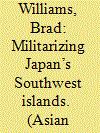| Srl | Item |
| 1 |
ID:
139032


|
|
|
|
|
| Summary/Abstract |
In July 2014, Japanese Prime Minister Shinzo Abe announced that his cabinet had approved a reinterpretation of the country’s constitution. Although Article 9 of the document, effected in 1947, stated that Japan had forever renounced war as a sovereign right, the change meant that the Japanese Self- Defense Forces (JSDF) would, for the first time since their founding in 1954, be permitted to participate in acts of collective self-defence (generally understood to be the right to use force to repel an armed attack against a foreign country that has a close relationship with one’s own country). Abe’s historic plan sparked criticism from China and South Korea, two countries affected by Japanese aggression during the Second World War. Both countries issued warnings about the resurgence of Japanese militarism, amid growing concerns that both China and Japan were leading an arms race in East Asia.
|
|
|
|
|
|
|
|
|
|
|
|
|
|
|
|
| 2 |
ID:
140775


|
|
|
|
|
| Summary/Abstract |
This paper sheds light on a relatively underexplored aspect of Japan’s recent security changes by examining the subnational level where the impact has been far-reaching. It focuses on Japan’s maritime frontier zone: the Yaeyama Islands located at the southwestern end of the Japanese archipelago and administered as part of Okinawa Prefecture. It argues that while Yaeyama militarization has been primarily a national response to China’s portrayed assertiveness in the East China Sea, it has also been facilitated by the strategic actions of local political elites, in cooperation with sympathetic extra-local forces. Political elites from two islands, Yonaguni and Ishigaki, have been motivated primarily by diverging material and ideational factors. Yonaguni elites have viewed militarization largely through the prism of “compensation politics.” Their counterparts in Ishigaki have been driven by more ideological objectives, seeking militarization for deterrence purposes and otherwise transforming the island into a rightist breeding ground in defence of Japanese territory. Yaeyama militarization has not only diminished enthusiasm for seeking autonomy and enhancing economic security through microregional cooperation, but has also enhanced local-level insecurities while creating and exacerbating divisions.
|
|
|
|
|
|
|
|
|
|
|
|
|
|
|
|
| 3 |
ID:
011653


|
|
|
|
|
| Publication |
Fall 1996.
|
| Description |
276-290
|
|
|
|
|
|
|
|
|
|
|
|
|
|
|
|